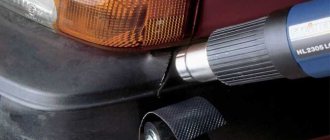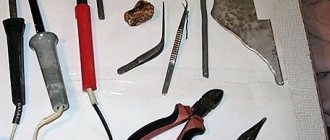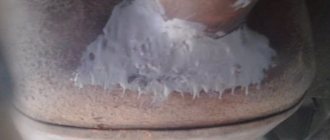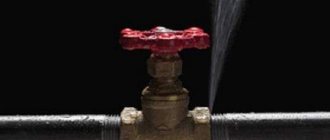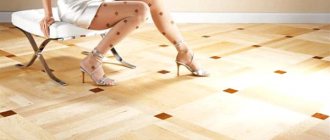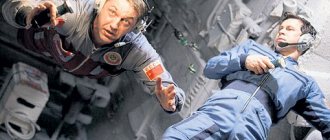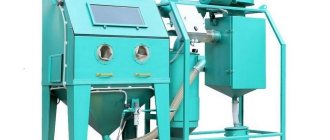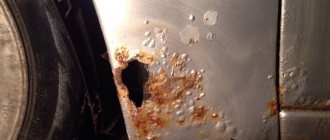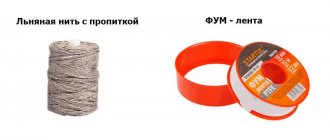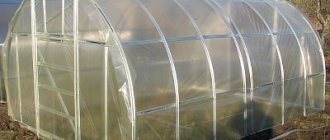Many drivers have encountered the problem of cracks appearing on their car bumpers. If it is plastic, then you can repair the damaged area yourself. There are many different ways to restore the aesthetic appearance of a bumper made of this material without resorting to the services of a car service.
Below we will discuss in detail the process of self-repairing damaged parts of a car body.
How to repair a bumper by hand is possible, but it’s better not to
- Let's start with the most famous and controversial method - soldering a brass mesh into a fracture. The essence of the repair is to use a powerful soldering iron to heat the mesh until it is immersed in the molten plastic. The method really allows you to hold together cracked pieces of the bumper, and you will be able to meet dozens of craftsmen who “have been doing this for 100 years and no one has complained yet,” but this technology has a number of disadvantages: metal, brass plates and plastic have different temperature expansion coefficients, so the repair area is not a monolithic structure;
- metal corrosion. Brass has very good resistance to rust, but often damaged parts are soldered or screwed into metal parts, which begin to corrode over time. The process occurs especially quickly if individual fragments of soldered metal parts remain openly sticking out from the inside of the element. Rust will penetrate inside in a relatively short time, thereby compromising the strength of the connection, and can even cause a defect in the paintwork (paintwork) on the outside of the bumper;
- loss of elasticity with a large repair area. In the cold, long cracks after soldering the mesh plates become oak, which is why even a slight deformation of the bumper can lead to new cracks.
Repair errors
The main mistakes during repairs usually relate to the final part of the processing - painting. If you make a mistake with the choice of materials and technology, then the repair simply will not take place.
There are four main mistakes that can result in a repaired bumper quickly losing its attractiveness:
- poor processing of plastic with cleaning agents. The cleaner should remove not only dirt, but all types of oils and fats;
- wrong type of putty. The putty should be specifically for plastic, not metal;
- The old paintwork has not been cleaned well enough. Before priming, the bumper must be sanded completely from the front side. This way the surface of the old paintwork will be “matted” and the primer will adhere equally well to the entire part.
They “forgot” to improve surface adhesion. The bumper must first be treated with adhesive primer. And then apply primer-filler for plastic, base and varnish.
Instructions. DIY soldering of plastic using brass mesh
For repairs, you will need a soldering iron with at least 40 W (preferably 60 or 100 W). Prepare pieces of brass mesh of such a size that, after soldering, there is about 2 cm of overlap to the sides of the crack. You need to solder the mesh on the inside of the bumper.
If the bumper is split or a large missing piece needs to be soldered, secure the parts with plastic ties or metal plates before starting soldering.
Drill holes along the perimeter of the fault in increments of 2-3 cm through which you can stretch the ties. The plates are fastened with bolts and nuts using the same principle.
After tacking in several fragments and reliably connecting the screed sections, the plates should be removed in order to properly solder the fracture site. If the broken pieces are small, grab them from the outside with a heated soldering iron (the tip must be recessed to half the thickness of the bumper).
Soldering points must be cleared of old paintwork. After tacking, be sure to reinforce the structure from the inside with mesh or epoxy and fiberglass. To reinforce the mesh, use a heated soldering iron to press it down approximately to the middle of the thickness of the plastic. On the front side, try to leave the surface as smooth as possible, since you most likely do not have an orbital sander, and it is difficult to sand the plastic by hand.
Methods for sealing cracks
Depending on the amount of damage and the type of plastic, the following methods for cracked bumpers are practiced:
- cosmetic bonding using acetone and donor plastic;
- sealing with modern chemical compounds;
- fastening with epoxy resin using fiberglass reinforcing mesh;
- sealing the crack with a soldering iron reinforced with metal mesh;
- welding using a hot air gun and a plastic rod.
Reference. There is one simple method used by car enthusiasts who are not too concerned about the appearance of the car. This is connecting the edges of a crack with wire or staples. This is a simple matter, which means there is no point in considering this technology, everything is already clear.
Binding a crack around the edges with wire does not look very attractive.
Using acetone, which can dissolve many types of plastics, for gluing is a temporary measure used for small cracks that appear in the middle of the body kit. Its essence is this:
- Pieces of plastic similar in composition to the bumper material are selected and dissolved in acetone to a thick consistency.
- On the back side of the bumper, the crack is degreased and also treated with acetone to soften the surface.
- Liquefied plastic is applied to the damage from the reverse side, after which it hardens for several hours. The outside of the defect can be touched up with a corrector tube.
A crack covered with plastic dissolved in acetone
Using thick two-component compounds sold in two tubes, any single cracks in most types of plastic can be sealed. The exception is fiberglass body kits; they are glued together with epoxy resin, and in case of serious damage, fiberglass mesh reinforcement is used.
A single crack can be sealed or soldered
With numerous large cracks, breaks and holes in the bumper, gluing methods become ineffective. In such cases, soldering or welding with a hot air gun using donor polymer material is practiced. After such repairs, the defect area is thoroughly cleaned and painted in the color of the car. At the end, it is necessary to completely polish the bumper so that the painted area does not stand out against the background of the old coating.
Advice. If you get into an accident or collide with a stationary obstacle and break the body kit, try to collect all the flying pieces, except for the smallest ones. This will allow you to use “original” plastic for repairs and not look for something similar.
Do-it-yourself plastic restoration using fiberglass
For DIY repairs, you can buy a kit for repairing plastic bumpers, which includes:
- polyester resin;
- hardener;
- a small piece of fiberglass fabric.
- Fiberglass can be used as a replacement for brass mesh to reinforce the inside of the bumper. Using fiberglass, it will be possible to restore the missing elements of the part, holes for parking sensors, etc. Without the use of fiberglass, it is almost impossible to repair tuning bumpers, the construction of which uses polyurethane foam or fiberglass.
Technology
The repair instructions are based on the example of the Novol Plus 710 Repair box.
- Clean the repair area from dirt and bitumen stains.
- Using abrasive P80-P120, sand. Sanding removes the outer layer of plastic and thereby increases resin adhesion. The old paintwork is polished with the same abrasives if work is carried out on the outside of the bumper.
- Cut the glass mat so that the finished pieces protrude beyond the crack by at least 2-3 cm.
- Degrease with a clean rag soaked in 646 solvent.
- In a separate container, prepare a polyester mixture (2-3 g of hardener per 100 g of resin). At a temperature of 20C you have 10-15 minutes to work with the finished mixture, so you need to knead it in small portions.
- Using a brush, apply epoxy to a small area of the repair area and lay glass mat on it. Using a brush soaked in the adhesive, press the fiberglass fabric evenly and expel all air bubbles.
- Applying more than 3 layers of fiberglass at a time prevents the bottom layer from drying out quickly. We recommend observing intervals between layers of drying (approximately 10-15 minutes at 20? C). Full polymerization occurs in 50-60 minutes, after which the section can be polished with abrasive materials.
Some subtleties
Retail fiberglass is classified in grams per m2. The coarser the fiberglass, the lower the grams/m2. For the final layers of the front component of the bumper, it is best to use glass mat (600-700 g/m2), since it is the easiest to process in preparation for painting. On the outside, try to apply the resin and lay the fiberglass mat as evenly as possible by hand to reduce the amount of sanding required later in preparation for painting. For initial processing by hand, use P80-P120 sandpaper. To level the surface of the bumper, plastic putty is applied to the repair area.
The putty is polished with abrasives P120, P240, P320.
An acrylic primer is applied to the prepared and degreased surface in several layers. Before painting, primed areas are sanded with P320, P600 abrasives.
This preparation method is universal and is suitable both for fiberglass repairs and for preparing the front side after soldering the bumper with electrodes.
Answers to frequently asked questions
How to solder the fastening (ear) of a plastic bumper?
In order to reliably solder the bumper fasteners without loss of strength, the repair site must be reinforced with reinforcement. You can use wire mesh, hot staples, or regular construction staples for this.
How to solder a large crack on a car bumper?
A large crack must be sealed, ensuring that its edges are tightened and reinforced. Large holes and breaks can be repaired using composite material (fiberglass or fabric + polyester resin).
Is it possible to solder a bumper with a metal rod?
It only makes sense to use a non-melting metal rod as a heating element. You should not solder plastic parts with metal solder.
DIY tool for welding bumpers with electrodes
The technology of welding plastic parts currently makes it possible to achieve excellent quality repairs at home. For repairs you will need:
- soldering station or heat gun with a special nozzle for soldering car bumpers. A professional soldering station complete with a soldering iron will cost about $100, but a soldering iron can be purchased separately. The only drawback of construction hair dryers is that the soldering attachments lead to overheating of the heating element and rapid failure of the hair dryer. If you plan to repair bumpers and other plastic elements, then purchasing a soldering station will be the best solution.
- Electrodes. Unfortunately, the cost of ready-made twigs for soldering is quite high. Therefore, it is better to make them yourself from available materials. Only compatible types of plastic can be used as electrodes. Most car bumpers are made of polypropylene alloys (PP, PP-EDM) or ABS. Without much difficulty, a similar type of plastic can be found among headlight housings and fender liners, of which there are a great many in the landfills of garage cooperatives and body repair stations. It is most convenient to use an engraving machine to sand and clean the repair area.
Repair technology
Each type of plastic has a threshold melting temperature, significantly exceeding which leads to loss of elasticity and strength. How to weld a bumper yourself:
- sand the old paintwork at the repair point with P80-P120 abrasive;
- to form a strong Y-shaped seam, the crack walls need to be slightly expanded;
- Observing the temperature regime, first heat the plastic and then the electrode itself. When laid correctly, the descending rod should be preceded by a ball of molten plastic.
- For reliable welding, it is important that the area where the electrode is placed is also heated.
- Following the technology, place the electrodes not only along the crack, but also at several points across the fault line.
Types of damage
There are four types of local damage that can be repaired:
- scratches;
- dents;
- cracks;
- through holes.
They are not always found in their “pure” form. Often after “contact” the bumper has all types of damage, from scratches to breaks. But even a deep scratch on plastic, after careful inspection, may turn out to be a “camouflaged” crack. Especially when the impact with the front bumper is tangential. In such cases, do-it-yourself bumper repair includes all types of operations to restore integrity and decorative appeal.
How to determine the type of plastic without markings
- take a glass of cold tap water,
- cut a small piece of your plastic, about 1 centimeter in size, a couple of millimeters thick,
- clean this piece so that it is free of dust and oils,
- dip a piece into a glass: if the plastic floats easily on the surface, it is most likely thermoplastic labeled PE, PP, PP+EPDM ;
- If a piece has sunk, try to set it on fire; if it burns, most likely it is thermoset, marked PUR/TPUR , if it does NOT burn,
- most likely it is PC
Recommendations for preparation
The preparatory process differs little for different methods of gluing and welding polymer parts, so it is worth considering separately. The first question is whether it is necessary to remove the bumper to make repairs. In most cases, dismantling is not possible, since the plastic must be sealed on both sides. The exception is broken body kits, cracked in many places. They must first be fastened together and then removed. Otherwise, after repair, the part may lose its shape, causing the attachment points to not meet, and the gaps with adjacent elements will increase.
The body kit cannot be removed in this state, it must first be secured
Reference. Often the bumper body comes off at the attachment points and small pieces of plastic remain on the screws. Before dismantling, such a part is securely welded to the torn fastener and only then removed.
To prepare a damaged body kit for repair, you need the following tools and materials:
- a set of keys and screwdrivers for removing the element;
- electric grinder;
- sandpaper of different grain sizes - from P180 to P320;
- degreasing liquid - organic solvent or white spirit;
- rags.
Sanding with a grinder speeds up the work significantly.
Note. Using a grinding machine, you can perform cleaning better and much faster than by hand. This and other power tools that will be needed for painting and polishing can be rented for 2-3 days.
Regardless of whether the work is carried out directly on the car or with the bumper removed, it must be thoroughly washed and dried. Then, using coarse sandpaper, you need to peel off the paint at a distance of 3-5 cm from the crack in each direction and sand the area with fine sandpaper. Whatever repair method you choose, the paint must be removed to the base, otherwise it will interfere with the adhesion of the glue or the fusion of polymers during welding. Finally, the area should be degreased.
The surface must be degreased after each cleaning.
Advice. The quality of body kit repair depends on the conditions in which it is performed. It is more convenient to repair damage in a garage equipped with an inspection ditch for easy removal of the part and soldering of the fallen fasteners in place.
Two-component bonding
To implement this method, you need to purchase the following bumper repair kit from the 3M brand:
- 2 FPRM components for preparing liquid polymer in 150 ml tubes (price - about 2500 rubles);
- special hard tape;
- self-adhesive reinforcing mesh made of fiberglass (otherwise known as fiberglass) 48 mm wide;
- adhesion initiator in an aerosol can;
- 2 spatulas - wide and narrow;
- stationery knife;
- gloves, safety glasses.
Two-component 3M compound for gluing plastics
Reference. Similar sets are offered by other manufacturers, but the 3M brand is the most well-known and proven in practice.
Liquid polymer gluing kit
Liquid polymer gluing is suitable for most plastics and can be done both with the body kit removed and on the car. True, the second option is quite inconvenient, plus you will need good lighting in the inspection hole. To cut a crack, you will need an electric drill (not a grinder!) with a mandrel for abrasive wheels. Repair consists of the following technological operations:
- Using a drill at low speed and an abrasive wheel, chamfer the edges of the crack on both sides at an angle of about 30°. In cross section it looks something like this: “>
- Degrease the area and allow time for the solvent to evaporate completely. On the front side of the bumper, where the paint has already been cleaned off at the preparatory stage, stick tape along the entire crack. It will serve as a kind of formwork when pouring a two-component solution.
- Treat the damaged area on the back side of the body kit with an adhesion initiator from a bottle, then apply a self-adhesive glass canvas over the split.
- Mix the components from the tubes in a 1:1 ratio using a spatula. Apply the liquid polymer to the mesh in several thin layers to prevent air pockets from forming. Apply the mixture until it completely covers the glass fiber.
- After laying the compound, give it 30 minutes to cure, then remove the tape from the front side and repeat the sealing operation (but without the mesh).
- After hardening, sand the area using alternately P180, P240 and P400 sandpaper. At this point, the plastic repair is complete and you can begin painting.
This is interesting: Vest for the driver, reflector for the pedestrian
Uneven surfaces must be filled with putty before painting.
Important! After mixing the components, the composition must be used within 6 minutes, which is enough to apply to the damage on one side. The curing time of 30 minutes is correct for a room temperature of 21-23°C, so when working in a cold room, it is necessary to organize local heating of the bumper (for example, with an infrared heater).
The penultimate operation is painting, after which polishing is done.
If unevenness is noticeable on the front side of the element, then before painting, apply a little putty intended for plastic to the differences. After drying, sand it with P1500 sandpaper, degrease it and spray paint it, after applying a layer of primer. After 1 day, polish the surface of the body kit.
Sealing with liquid polymer - photo
After cutting, manual cleaning of the crack is required. The inside of the body kit must also be sanded. Cutting the edges of the crack at an angle. Adhesive tape is glued to the front side. Glass canvas is glued to the inside. From the end you can see how the tape limits the flow of the composition outward when applying 2 components are squeezed out onto a spatula in the same amount. Mixing the components with a spatula. The composition is rubbed into the crack and the mesh with a spatula. After hardening and removing the tape, the sealed joint is cleaned. This is what a sealed crack in plastic looks like
